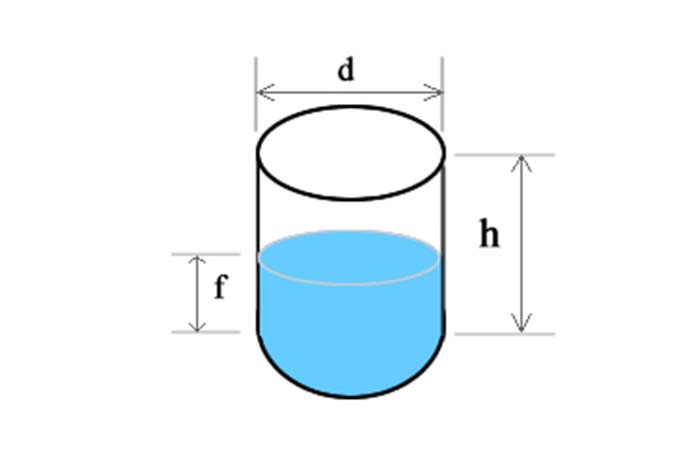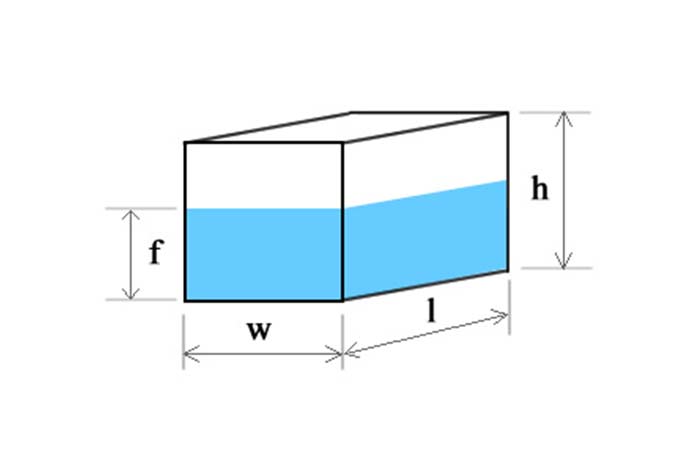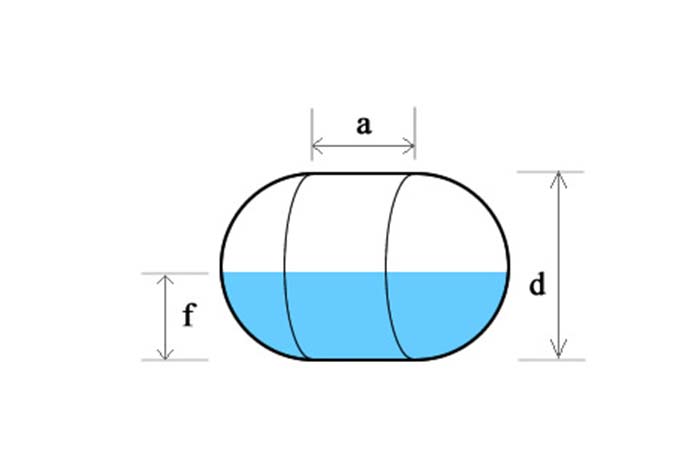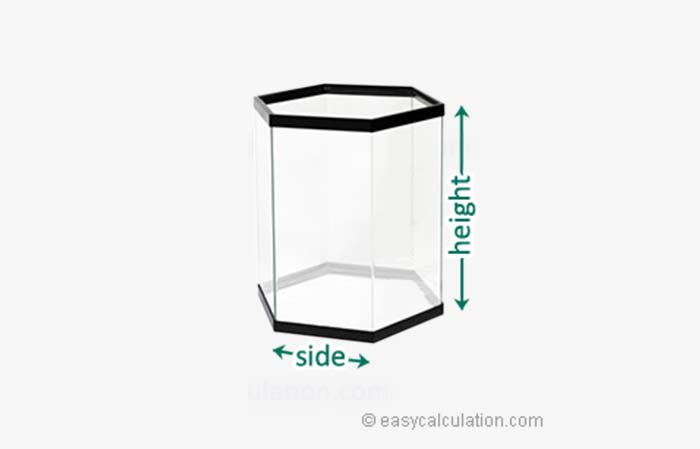The size of a fish tank is one of the very important factors that will determine how well your pet fish will live. The right dimensions will definitely provide a suitable habitat for your aquatic creatures which will eventually ensure healthy growing and minimal stress.
If you have been curious about fish tank sizes, this guide is for you. Learn all you need to calculate size in terms of gallons or volume, why size is important and considerations before selecting. In addition, find out the most common sizes of aquariums, their dimensions and prices.
How to calculate/measure Dimensions and Volume of the Tank
The calculation will depend the shape of the aquarium. Fish tanks come in rectangular, cylindrical, hexagonal, oval, capsule and many other more shapes.
Cylindrical Tanks

The volume of such a tank is calculated by multiplying the circular area by the tank height in inches. A = πr2 whereby the radius is found by dividing the diameter by 2 i.e d/2 and pie (π)= 22/7
Therefore, the volume of the full tank= πr2h
Fish tank size (US Gallons) = 3.1417 x r x r x h /231
In UK gallons = 3.1417 x 3.1417 x r x r x h x 0.833
In Litres = 3.1417 x 3.1417 x r x r x hx 3.785
Example
A cylindrical aquarium has a diameter of 16m and height of 10 m, then the size of the aquarium is
Fish Tank Size = 3.1417 x 8 x 8 x 10 / 231
= 531168.4361 US Gallons
In UK gallons = 3.1417 x 8 x 8 x 10 x 0.833
= 102209023.9804 UK Gallons
In Litres = 3.1417 x 8 x 8 x 10 x 3.785
= 464419154.5808 litres
For tanks that are filled with water to a height, f, then the size will be;
V (f) = πr2f
Simply substitute the original h with the f
Rectangular Tanks

The total volume is calculated by multiplying the length by width by height in inches, i.e:
V(full tank) = lwh
Tank Size (US Gallons) = (L x W x H) / 231
In UK Gallons = ((L x W x H) / 231) x 0.833
For tanks that are filled with water to a height, f, then substitute the new height(f) with the original H.
V(f) = lwf
Oval Tanks

To find the volume of such a tank, calculate the area of the end then multiply by the length.
A = πr2 + 2ra and V(full tank) = (πr2 + 2ra)l
In case f < r
Calculate the volume by using the circular segment technique
In case f > r and f < (r+a)
The water volume would be half the cylinder portion plus the rectangular volume filled with water
In case f > (r+a) and f < h
In this case, calculate the volume using the circular segment technique then;
Total Volume= Volume in V(tank) – V(segment).
Capsule Tanks

To calculate the volume of such a tank:
V(sphere) = (4/3)πr3
V(cylinder) = πr2a
V(capsule) = πr2((4/3)r + a)
Therefore, total Volume= V(sphere) + V(cylinder) + V(capsule)
Hexagonal Fish Tank
For exagonal shaped aquariums, following is the formula

Tank Size (US Gallons) = ((3 x √3 / 2 x Length of One Side2 in Inch) x Height in Inch) / 231
In UK Gallons = s x 0.833
In Litres = s x 3.785
Where,
s = Aquarium Size (In US gallons)
Below is an example from easycalculation.com
A fish tank with length 10 m, height 7 m will have a volume of
volume = ((3 x √3 / 2 x 102) x 7
volume = 7.873 gallons
In UK gallons ,
volume = 7.873 x 0.833
volume = 6.5582
In Litres,
Volume = 7.873 x 3.785
volume = 29.7992
Popular Tank Sizes
Fish tanks come in various sizes ranging from show tanks, regular and long tanks. All these tanks are suitable for the different environment; some are for home exhibition while others are for public exhibition. Here are a few popular fish tank sizes available in the market:
Nano Aquariums
These aquariums have a capacity of 20 gallons and can house both salty water and freshwater fish. They are suitable for displaying a self-contained and tiny ecosystem.
Oceariums
These are suitable for large fish
species exhibition and are typically larger than home aquariums. They have a
capacity of 6.3 million gallons of water.
Glass Bowl Aquarium
These have a capacity of at least 1 liter but houses few fish. They have pH and temperature fluctuations and may be unstable for fish.
Here are a few fish tank sizes for some common freshwater fish. These are the best sizes for the fish:
| Fish Sample | Fish Size in Inches | Gallons | Tank Dimensions |
| Neon Tetra | 1.5 | 1 | 7.50″ x 7.50″ x 10.25″ |
| Beta Fish | 3 | 2.5 | 12″ x 6″ x 8″ |
| Goldfish | 5 | 10 | 20″ x 10″ x 12″ |
| Guppies | 2 | 1 | 7.50″ x 7.50″ x 10.25″ |
| Zebra Danios | 2 | 2.5 | 12″ x 6″ x 8″ |
Size Chart
| Tank Size | Outside Dimensions in Inches (L x W x H) | Weight Empty and Full (lbs) | Tempered Glass | |
| 10 Leader | 20 1/4 x 10 1/2 x 12 9/16 | 11 | 111 | |
| 15 High | 20 1/4 x 10 1/2 x 18 3/4 | 22 | 170 | |
| 20 X-High | 20 1/4 x 10 1/2 x 23 3/4 | 32 | 232 | |
| 10 Long | 24 1/4 x 8 1/2 x 12 5/8 | 16 | 116 | |
| 15 Show | 24 1/4 x 8 1/2 x 16 5/8 | 22 | 170 | |
| 15 Gallon | 24 1/4 x 12 1/2 x 12 3/4 | 21 | 170 | |
| 20 High | 24 1/4 x 12 1/2 x 16 3/4 | 25 | 225 | |
| 25 Gallon | 24 1/4 x 12 1/2 x 20 3/4 | 32 | 282 | |
| 30 X-High | 24 1/4 x 12 1/2 x 24 3/4 | 41 | 340 | |
| 20 Long | 30 1/4 x 12 1/2 x 12 3/4 | 25 | 225 | |
| 29 Gallon | 30 1/4 x 12 1/2 x 18 3/4 | 40 | 330 | |
| 37 Gallon | 30 1/4 x 12 1/2 x 223/4 | 45 | 415 | X |
| 26 Flatback | 36 1/4 x 12 1/2 x 16 5/8 | 42 | 300 | X |
| 23 Long | 36 1/4 x 12 5/8 x 13 | 32 | 253 | |
| 30 Gallon | 36 1/4 x 12 5/8 x 16 3/4 | 43 | 343 | |
| 38 Gallon | 36 1/4 x 12 5/8 x 19 3/4 | 47 | 427 | |
| 45 Gallon | 36 1/4 x 12 5/8 x 23 3/4 | 66 | 515 | X |
| 30 Breeder | 36 3/16 x 18 1/4 x 12 15/16 | 48 | 348 | |
| 40 Breeder | 36 3/16 x 18 1/4 x 16 15/16 | 58 | 458 | |
| 50 Gallon | 36 7/8 x 19 x 19 5/8 | 100 | 600 | |
| 65 Gallon | 36 7/8 x 19 x 24 5/8 | 126 | 775 | |
| 33 Long | 48 1/4 x 12 3/4 x 12 7/8 | 52 | 382 | X |
| 40 Long | 48 1/4 x 12 3/4 x 16 7/8 | 55 | 455 | X |
| 45 Long | 48 1/4 x 12 3/4 x 19 | 60 | 510 | X |
| 55 Gallon | 48 1/4 x 12 3/4 x 21 | 78 | 625 | X |
| 60 Gallon | 48 3/8 x 12 7/8 x 23 7/8 | 111 | 710 | X |
| 80 X-High | 48 7/8 x 14 x 30 3/4 | 200 | 990 | |
| 75 Gallon | 48 1/2 x 18 1/2 x 21 3/8 | 140 | 850 | |
| 90 Gallon | 48 1/2 x 18 1/2 x 25 3/8 | 160 | 1050 | |
| 110 X-High | 48 7/8 x 19 x 30 3/4 | 228 | 1320 | |
| 120 Gallon | 48 1/2 x 24 1/4 x 25 1/2 | 215 | 1400 | |
| 100 Gallon | 72 1/2 x 18 1/2 x 19 3/8 | 182 | 1150 | |
| 125 Gallon | 72 1/2 x 18 1/2 x 23 3/8 | 206 | 1400 | |
| 150 Gallon | 72 1/2 x 18 1/2 x 28 1/2 | 338 | 1800 | |
| 180 Gallon | 72 1/2 x 24 1/2 x 25 5/8 | 338 | 2100 | |
| 2 1/2 Mini | 12 3/16 x 6 1/8 x 8 1/8 | 2.6 | 27 | |
| 5 1/2 Gallon | 16 3/16 x 8 3/8 x 10 1/2 | 7 | 62 | |
| 4 Designer | 8 1/4 x 8 1/4 x 18 7/8 | 9 | 49 | |
| 6 Designer | 8 1/4 x 8 1/4 x 24 7/8 | 10.5 | 70 | |
| 10 Designer | 13 5/8 x 13 5/8 x 19 | 18.5 | 115 | |
| 15 Designer | 13 5/8 x 13 5/8 x 25 | 25.5 | 175 | |
| 10 Hexagon | 14 1/2 x 12 9/16 x 18 3/4 | 12 | 110 | |
| 20 Hexagon | 18 3/4 x 16 1/4 x 20 5/8 | 23 | 220 | X |
| 35 Hexagon | 23 1/4 x 20 3/16 x 24 3/4 | 43 | 390 | X |
| 60 Hexagon | 27 1/4 x 24 1/8 x 29 1/2 | 110 | 750 | X |
Why is Fish Tank Size Important?
You might be wondering why the size of the aquarium you purchase is important. Well, the size of the tank determines the number and type of fish that can be accommodated in the aquarium. Generally, fish require big tanks since it ensures they remain healthy and happy at all times.
According to Melbourne’s Premier Aquarium Leasing & Aquarium Maintenance, a professional tank maintenance company, when you confine your fish in small tanks, they tend to be stressed, anxious and extremely aggressive due to the stressful habitat. Small tanks can kill the fish by suppressing their growth thus their organs lack enough room to develop, resulting in organ failure.
The right tank size ensures enough gallons of water are available for the fish; therefore, they acquire a constant supply of oxygen. A smaller aquarium means less water that translates to less oxygen. Insufficient water prevents gaseous exchange between the atmosphere and water, thus your fish might end up suffocating due to lack of oxygen supply.
When purchasing a fish tank, be cautious of the size and consider the room and resources necessary for the number of fish you wish to accommodate.
Factors to consider when picking the Tank Size
Size of the Fish
To begin with, you should take into account the length of the fish since, upon maturity, the fish might end up overcrowding the aquarium. Some fish are slender while others are pudgy. The right tank size offers these creatures a perfect habitat to thrive.
Small fish take up more water for every gram of body weight as opposed to large fish. For instance, labyrinth fish can take in oxygen from the atmosphere hence they do not require much surface area.
However, they can at times be territorial hence require large space. In addition, barbs would require a huge tank as opposed to tetras, considering they are of similar size.
Oxygen and Carbon Dioxide Concentration
Gaseous exchange at the tank surface is a vital constraint, thus has an impact on the size of an aquarium. Various aquarists argue that a deep aquarium and a shallow one with similar surface area can hold a similar amount of fish.
You can, however, improve the fish capacity through water circulation and surface movement, i.e. through aeration. This improves both the gaseous exchange and waste decomposition rate in the aquarium.
Surface Area
You should also consider the tank’s surface area. This has a direct impact on the fish respiration since they breathe. The tanks’ ability to circulate air is vital and is dependent on the surface area.
Use of Cold or Warm Water
You must consider whether the fish use hot or cold water in the aquarium. Cold-water fish and tropical fish have their differences thus you need to consider this factor. Cold-water fish require 25 to 30 square inch for each fish while the tropical counterparts need 20 to 25 inches for each adult fish.
Warm water has a low oxygen-dissolving rate as compared to cold water and this impacts the tank size since warm conditions make fish more active. They would, therefore, need more air circulation.
Fish Compatibility
As mentioned earlier, fish thrive well in tanks that are suitable for their size. In case you have large fish, they would need large tanks as opposed to smaller fish that thrive perfectly in smaller tanks.
Also, consider the possibility of overcrowding the tank without overstocking; this could happen when you place big fish in small tanks. This way, you might find that the fish has suitable oxygen load, filtration capacity and adequate water yet the fish remain uncomfortable due to overcrowding.
Planted Freshwater Aquariums
For these aquariums, it is vital to balance the size, light duration, and quality of the aquarium. This is simply due to the carbon dioxide produced by both plants and fish. Given a certain amount of light, if the plants or carbon dioxide concentration is insufficient to consume waste produced by fish, it would always result in algae growth.
In case there are few plants in the tank, consider increasing the tank size or regulation of carbon dioxide and waste to reduce the impact it would have on fish.
To conclude, it is evident that to find a suitable tank size, there are rules that you should follow. There is no suitable tank size for your fish; you should consider the following rules:
- Large aquariums are easy to maintain in terms of water management and cleaning.
- When picking an aquarium, pick one that is large enough to prevent stressing the fish.
- In case you cannot acquire a big aquarium, consider picking smaller fish species to provide a suitable habitat for the fish.
- Larger tanks translate to happier fish.
More on Fish Tanks & Aquariums






